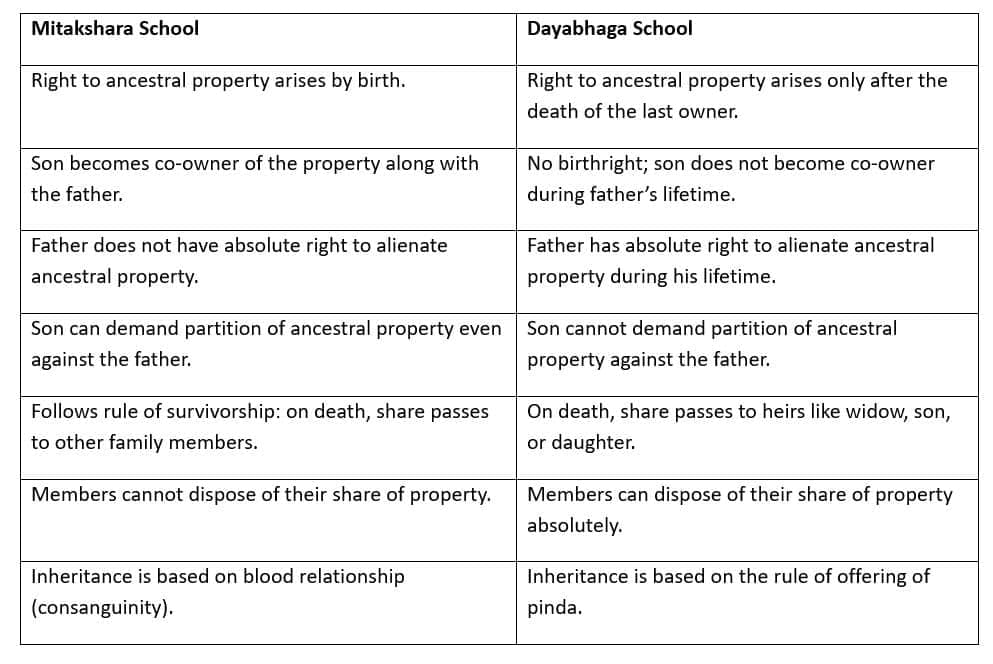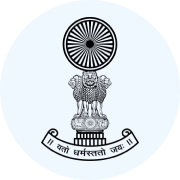Judiciary Exams Exam > Judiciary Exams Notes > Civil Law for Judiciary Exams > Mitakshara and Dayabhaga Schools
Mitakshara and Dayabhaga Schools | Civil Law for Judiciary Exams PDF Download
| Table of contents |

|
| Mitakshara and Dayabhaga Schools of Hindu Law |

|
| Mitakshara School Overview |

|
| Dayabhaga School Overview |

|
| Differences Between Dayabhaga School and Mitakshara School |

|
Mitakshara and Dayabhaga Schools of Hindu Law
The Mitakshara and Dayabhaga schools are two prominent schools of Hindu law in India that govern property inheritance and individual rights to property.
History of Mitakshara School
- The Mitakshara school is based on Vijnanesvara’s 12th-century commentary on the Yajnavalkya Smriti.
- It is primarily followed in North India and is known for its emphasis on joint family property.
- According to this school, ancestral property is shared among male family members, with sons having equal rights to inheritance.
- Mitakshara allows wills only for self-acquired property, not ancestral coparcenary property.
Key Concepts of Mitakshara School
- Joint family property is a central idea where all family members have a claim to ancestral property.
- Property is inherited through the male lineage, and sons inherit it equally.
- Recognition of the right to will away only self-acquired property, not ancestral coparcenary property.
History of Dayabhaga School
- The Dayabhaga school is based on Jimutavahana’s 12th-century digest, the Dayabhaga
- Primarily followed in Bengal and eastern India, this school focuses on individual ownership of property.
- Unlike Mitakshara, joint family property is not recognized in the Dayabhaga school.
- Dayabhaga gave better rights to women (widows, daughters) compared to Mitakshara, but not full equality.
Key Concepts of Dayabhaga School
- Emphasis on personal ownership of property, allowing owners control over distribution.
- Recognition of women's right to inherit property, ensuring daughters receive a fair share.
- Absence of the concept of joint family property in this school.
Differences between Mitakshara and Dayabhaga Schools
- Mitakshara promotes joint family property ownership, while Dayabhaga supports individual ownership.
- While sons inherit equally in Mitakshara, daughters also have inheritance rights in Dayabhaga.
- The schools have influenced India's legal system significantly and are practiced across the country.
Question for Mitakshara and Dayabhaga SchoolsTry yourself: Which school of Hindu law emphasizes joint family property ownership?View Solution
Mitakshara School Overview
- The Mitakshara school of Hindu law is primarily concerned with inheritance and succession practices.
- Named after the text Mitakshara, which elucidates the Yajnavalkya Smriti, this school is predominant in northern and western India.
- Central to the Mitakshara school is the concept of joint family property, where ownership rests collectively with the entire family rather than individuals.
Inheritance Methods in Mitakshara School
- By Birth: Property is inherited automatically by birth.
- By Adoption: Property can be inherited through the act of adoption.
- By Will: Property can be inherited as per the deceased's will.
- By Survivorship: In Mitakshara, the share of a deceased coparcener automatically passes to surviving coparceners.
Key Concepts
- Coparcenary: Traditionally, only male descendants up to four generations (son, grandson, great-grandson) were coparceners.
- Stridhana: Property exclusively owned by women through inheritance or gifts, protected from claims by husbands or other family members.
Sub-schools in Mitakshara School
- Banaras School: Located in Banaras, this sub-school prioritizes adherence to traditional Hindu texts in legal matters.
- Mithila School: Situated in the Mithila region, this branch advocates for equal inheritance rights for daughters, deviating from the traditional male-centric approach.
- Maharashtra School: Operating in Maharashtra, this sub-school interprets laws liberally, supporting individual ownership rights over joint family principles.
- Andhra School: Found in Andhra Pradesh, this branch underscores coparcenary, with male heirs jointly owning ancestral property, while daughters have different inheritance rights.
- Dravida School: Prevalent in Tamil Nadu and Kerala, this school emphasizes religious freedom, allowing individuals to follow personal beliefs alongside Hindu legal traditions.
These sub-schools emerged due to diverse interpretations and regional influences, each highlighting joint family ownership and inheritance within the broader Mitakshara tradition.
Dayabhaga School Overview
- The Dayabhaga school stands as a significant branch of Hindu law in India, alongside the Mitakshara school. It finds its stronghold in the eastern regions of India, particularly in Bengal, Assam, Orissa, and parts of Bihar.
- Originating from Sanskrit roots, "Daya" meaning compassion and "Bhaga" meaning share, the Dayabhaga school prioritizes an individual's rights to property over communal ownership, distinguishing it from the Mitakshara school. Here, an individual retains complete authority over property distribution. In this system, heirs do not automatically inherit their parents' belongings; instead, inheritance is either dictated by the deceased's will or by rules based on the closeness of relationships.
- Jimutavahana’s Dayabhaga is mainly a digest on Yajnavalkya Smriti and other texts, not Manusmriti.
- It has no sub-school.
Question for Mitakshara and Dayabhaga SchoolsTry yourself: What is the central concept of the Mitakshara school of Hindu law?View Solution
Differences Between Dayabhaga School and Mitakshara School
Origins and Significance
- The Dayabhaga school originated from Jimutavahana's text, while the Mitakshara school is based on Vijnaneswara's commentary on the Yajnavalkya Smriti.
- Both schools are crucial in understanding Hindu law of succession and property rights across India.
Geographical Influence
- Mitakshara school is prominent in northern and western India, while Dayabhaga school is dominant in eastern regions like Bengal, Assam, Orissa, and parts of Bihar.
- This geographical divide leads to distinct legal frameworks reflecting cultural diversity.
Concept of Joint Family and Coparcenary
- Mitakshara grants coparcenary rights to male descendants, allowing them to share ancestral property during the father's lifetime.
- Dayabhaga asserts that sons gain ownership only after the father's death, influencing family asset management.
Partition and Inheritance
- In Mitakshara, partition defines shares of coparceners, ensuring equitable distribution.
- Dayabhaga involves physical separation of property for each coparcener, impacting inheritance planning.
Rights of Women
- In Mitakshara, women have rights in property partitions, acknowledging their position in the family.
- Dayabhaga treats women differently as fathers retain ownership, limiting women's entitlements.
Impact on Hindu Society
- These schools influence family dynamics, property management, and succession planning.
- Mitakshara fosters joint family cohesiveness but poses challenges in property division, while Dayabhaga emphasizes individual ownership.
Continuing Relevance
- In modern India, these schools still shape inheritance laws and practices.
- Legal reforms engage with these traditions while balancing evolving societal needs.
The difference between Mitakshara and Dayabhaga Schools can be summarised as:

The document Mitakshara and Dayabhaga Schools | Civil Law for Judiciary Exams is a part of the Judiciary Exams Course Civil Law for Judiciary Exams.
All you need of Judiciary Exams at this link: Judiciary Exams
|
363 docs|256 tests
|
FAQs on Mitakshara and Dayabhaga Schools - Civil Law for Judiciary Exams
| 1. What are the key differences between the Dayabhaga School and the Mitakshara School of Hindu Law? |  |
Ans. The key differences between the Dayabhaga School and the Mitakshara School include the inheritance rules, succession rights, and the concept of joint family property.
| 2. How do the Dayabhaga and Mitakshara Schools differ in terms of succession rights? |  |
Ans. In the Dayabhaga School, succession rights are based on the principle of propinquity, while in the Mitakshara School, succession rights are based on the principle of survivorship.
| 3. What is the main concept behind the Mitakshara School of Hindu Law? |  |
Ans. The Mitakshara School follows the concept of joint family property and includes the concept of coparcenary rights.
| 4. How does the Dayabhaga School differ from the Mitakshara School in terms of inheritance rules? |  |
Ans. The Dayabhaga School follows the principle of propinquity in inheritance, while the Mitakshara School follows the principle of survivorship.
| 5. What is the significance of understanding the differences between the Dayabhaga and Mitakshara Schools in the context of Hindu Law? |  |
Ans. Understanding the differences between the Dayabhaga and Mitakshara Schools is important for legal practitioners and individuals involved in matters related to inheritance and succession rights under Hindu Law.
Related Searches




















